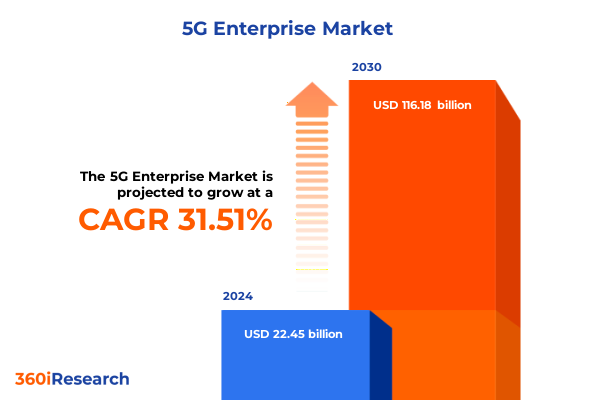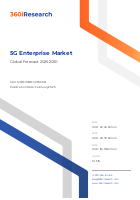The 5G Enterprise Market size was estimated at USD 22.45 billion in 2024 and expected to reach USD 29.79 billion in 2025, at a CAGR 31.51% to reach USD 116.18 billion by 2030.

Executive Overview: Introducing the 5G Enterprise Revolution
The evolution of network infrastructure is reaching an unprecedented phase with the advent of 5G Enterprise technologies. In this transformative period, organizations are finding that the leap to 5G is more than simply a technical upgrade—it is a gateway to a fundamentally reimagined operational landscape. This report introduces a detailed exploration of the new era for enterprise connectivity, anchoring its discussion on the critical factors that drive market growth and technological adoption. Enhanced connectivity, reduced latency, and higher data around the clock are fostering innovative business models, driving efficiency and redefining competitive advantage. Drawing on recent market trends and comprehensive industry data, this section sets the stage for a discussion of key themes that are shaping the evolution of network capabilities and digital transformation. The insights provided here highlight both the challenges and opportunities that stakeholders encounter as they adapt to a faster, more reliable, and secure connectivity environment.
Transformative Shifts Redefining the 5G Enterprise Landscape
Over the past few years, network evolution has accelerated the adoption of 5G technologies across multiple sectors, resulting in transformative shifts in the enterprise landscape. Deep integration of advanced spectrum efficiency, ultra-low latency, and high throughput connectivity has not only redefined operational paradigms but also spurred innovative applications that once seemed futuristic. Enterprises now leverage these advances to streamline operations, introduce new digital services and optimize resource allocation. This new epoch is characterized by a dynamic interplay between emerging technologies and legacy infrastructures, forcing industry leaders to re-strategize around investment in enhanced hardware capabilities, managed and professional services, as well as superior software solutions that enable network management and security. The rapid convergence of industries and seamless integration of cutting-edge network slicing and IoT solutions are catalyzing an environment where agility, security, and scalability are paramount. Such a landscape necessitates rethinking traditional business models and fostering collaboration across interdependent sectors to remain competitive in a digitally driven world.
Key Segmentation Insights: Unraveling the Complex Landscape
An in-depth analysis of the market reveals a complex segmentation framework that is critical to understanding the nuances of 5G Enterprise deployments. When considering the component factor, the market is broadly divided into hardware, services, and software, each offering distinct value propositions. The hardware segment is further categorized by 5G small cells, gateways, modems, and routers, each playing a specific role in establishing robust connectivity. On the services front, elements such as managed services, professional services, and support and maintenance come together to provide the infrastructure required for seamless operations. Notably, the professional services dimension includes both consulting expertise and integration initiatives, ensuring that deployment is both strategic and optimally executed. Meanwhile, in the software category, network management software, network security, and network slicing are critical enablers of control and performance. Shifting focus to applications, the market spans diverse needs from enhanced mobile broadband and fixed wireless access to massive machine type communications and ultra-reliable low latency communications, each driving unique requirements. Organizational size categorization further distinguishes the landscape by delineating opportunities in large enterprises versus small and medium-sized enterprises. In addition, the network type segmentation—comprising hybrid, private, and public networks—illustrates the layered approach to connectivity. The end-user segmentation, which spans verticals such as automotive where autonomous and connected vehicles are integral, energy and utilities with applications like remote asset monitoring, smart grids and smart meters, healthcare integrating remote monitoring, telemedicine and wearable devices, manufacturing with factory automation, predictive maintenance and robotics, media and entertainment through AR/VR experiences and content streaming, oil and gas enhancing operational efficiency and pipeline monitoring, as well as retail leveraging technologies like beacons and smart payments, further refines the ecosystem. Lastly, technology and usage scenarios—highlighting advancements in Internet of Things, multi-access edge computing and network slicing, alongside distinct usage scenarios from broadband access in dense areas to enhanced indoor coverage and the wireless home office—collectively underscore the layered complexity and opportunity within the 5G Enterprise market.
This comprehensive research report categorizes the 5G Enterprise market into clearly defined segments, providing a detailed analysis of emerging trends and precise revenue forecasts to support strategic decision-making.
- Component
- Application
- Organization Size
- Network Type
- End-User
- Technology
- Usage Scenario
Key Regional Insights: Navigating a Multi-Faceted Global Marketplace
A geographical lens into the market further accentuates regional variations that impact adoption and deployment strategies. In the Americas, dynamic regulatory environments and substantial investments in digital infrastructure offer promising avenues for accelerated growth. The Europe, Middle East & Africa region serves as a melting pot of diverse economic and technological ecosystems, where the balance of tradition and innovation influences market penetration and network customization. Across the Asia-Pacific, rapid urbanization, a high rate of smartphone penetration and an appetite for next-generation connectivity are pushing the envelope in terms of innovation and scale. Each region presents unique advantages and challenges, requiring tailored approaches and localized strategies to effectively leverage the potential of 5G Enterprise capabilities. The interplay between regional policies, market maturity and varying consumer expectations makes it imperative for strategists to adopt a nuanced and region-specific approach when planning deployments.
This comprehensive research report examines key regions that drive the evolution of the 5G Enterprise market, offering deep insights into regional trends, growth factors, and industry developments that are influencing market performance.
- Americas
- Asia-Pacific
- Europe, Middle East & Africa
Key Companies Insights: Profiling the Leaders in 5G Enterprise Innovation
Insights from key market players offer a vivid portrayal of a competitive arena characterized by technological innovation and strategic collaboration. Leading organizations such as Airspan Networks Holdings Inc., Amazon Web Services, Inc., and American Tower Corporation are at the forefront of developing cutting-edge hardware and network infrastructure technologies. They are complemented by established incumbents like AT&T Inc., Bell Canada Enterprises Inc. and Broadcom Inc., whose investments are bolstering service capabilities and comprehensive network management. Prestigious global corporations including BT Group PLC, Capgemini SE, and China Mobile Limited have also joined the contest, driving forward enterprise connectivity with robust research and agile implementation strategies. This competitive environment is further elevated by contributions from Ciena Corporation, Cisco Systems, Inc., and Comba Telecom Systems Holdings Limited, all of which continue to deliver innovations that redefine connectivity. Additional stalwarts like CommScope, Inc., Deutsche Telekom AG, Extreme Networks, Inc., F5, Inc. and FiberHome Telecommunication Technologies Co., Ltd. add layers of expertise by broadening the technological spectrum through diverse portfolio offerings. Prominent technology providers such as Fujitsu Limited, Hewlett Packard Enterprise Company, Huawei Technologies Co., Ltd., Kyocera Corporation, and Mavenir Systems, Inc. are instrumental in bridging the gap between established practices and future-forward digital transformation. Microsoft Corporation, NEC Corporation, Nokia Corporation, NTT DATA Corporation, Parallel Wireless, Inc., Qualcomm Incorporated, Reliance Industries Limited, Samsung Electronics Co., Ltd., SK Inc., Sunrise LLC by Liberty Global PLC, Telefonaktiebolaget LM Ericsson, Telstra Corporation Limited, Verizon Communications Inc., Vodafone Idea Limited, VVDN Technologies, and ZTE Corporation also play a critical role in driving growth, each making significant strides in integrating innovative solutions and services, thereby elevating market dynamics to new heights.
This comprehensive research report delivers an in-depth overview of the principal market players in the 5G Enterprise market, evaluating their market share, strategic initiatives, and competitive positioning to illuminate the factors shaping the competitive landscape.
- Airspan Networks Holdings Inc.
- Amazon Web Services, Inc.
- American Tower Corporation
- AT&T Inc.
- Bell Canada Enterprises Inc.
- Broadcom Inc.
- BT Group PLC
- Capgemini SE
- China Mobile Limited
- Ciena Corporation
- Cisco Systems, Inc.
- Comba Telecom Systems Holdings Limited
- CommScope, Inc.
- Deutsche Telekom AG
- Extreme Networks, Inc.
- F5, Inc.
- FiberHome Telecommunication Technologies Co., Ltd.
- Fujitsu Limited
- Hewlett Packard Enterprise Company
- Huawei Technologies Co., Ltd.
- Kyocera Corporation
- Mavenir Systems, Inc.
- Microsoft Corporation
- NEC Corporation
- Nokia Corporation
- NTT DATA Corporation
- Parallel Wireless, Inc.
- Qualcomm Incorporated
- Reliance Industries Limited
- Samsung Electronics Co., Ltd.
- SK Inc.
- Sunrise LLC by Liberty Global PLC
- Telefonaktiebolaget LM Ericsson
- Telstra Corporation Limited
- Verizon Communications Inc.
- Vodafone Idea Limited
- VVDN Technologies
- ZTE Corporation
Actionable Recommendations for Industry Leaders
Industry leaders must adopt a proactive and strategic approach to harness the full potential of 5G technologies. A primary recommendation is to invest in flexible and scalable infrastructure to accommodate rapid technological changes. Enterprises should prioritize partnerships with technology innovators and service providers to unlock integrated solutions that address multiple facets of the 5G ecosystem. Leaders are urged to develop cross-functional teams that integrate expertise in hardware, software, and services, fostering a holistic view of network design and operation. Continuous monitoring of regulatory developments and market trends is essential, as it allows agile adjustments to strategy in response to real-time challenges and opportunities. A framework for innovation that emphasizes customer-centric approaches and data-driven decision-making will enable organizations to capture emerging revenue streams while mitigating risks associated with disruptive transitions.
Explore AI-driven insights for the 5G Enterprise market with ResearchAI on our online platform, providing deeper, data-backed market analysis.
Ask ResearchAI anything
World's First Innovative Al for Market Research
Conclusion: Charting the Future of Connectivity in a Dynamic Market
In conclusion, the advent of 5G Enterprise heralds a transformative era for business operations and technological integration. This report has illuminated the multi-dimensional aspects of market segmentation, the diverse influences of regional variations, and the competitive dynamics driven by global market leaders. With a robust infrastructure and strategic foresight, enterprises are ideally positioned to leverage the benefits of faster, more reliable and secure connectivity. It is imperative for decision-makers to embrace a forward-thinking attitude and rigorously adopt innovative solutions that align with the evolving demands of the digital economy. The insights provided herein form a comprehensive roadmap, guiding industry participants toward sustainable growth and long-term competitive advantage in a rapidly changing technological landscape.
This section provides a structured overview of the report, outlining key chapters and topics covered for easy reference in our 5G Enterprise market comprehensive research report.
- Preface
- Research Methodology
- Executive Summary
- Market Overview
- Market Insights
- 5G Enterprise Market, by Component
- 5G Enterprise Market, by Application
- 5G Enterprise Market, by Organization Size
- 5G Enterprise Market, by Network Type
- 5G Enterprise Market, by End-User
- 5G Enterprise Market, by Technology
- 5G Enterprise Market, by Usage Scenario
- Americas 5G Enterprise Market
- Asia-Pacific 5G Enterprise Market
- Europe, Middle East & Africa 5G Enterprise Market
- Competitive Landscape
- List of Figures [Total: 31]
- List of Tables [Total: 822 ]
Call To Action: Connect with Ketan Rohom for Exclusive Market Insights
To explore a deeper understanding of the evolving 5G Enterprise landscape and gain valuable market insights, connect with Ketan Rohom, Associate Director, Sales & Marketing. Gain access to detailed analytical reports and strategic guidance designed to empower your next phase of innovation and digital transformation. Your next move in shaping the future starts here—reach out to unlock actionable insights and competitive intelligence today.

- How big is the 5G Enterprise Market?
- What is the 5G Enterprise Market growth?
- When do I get the report?
- In what format does this report get delivered to me?
- How long has 360iResearch been around?
- What if I have a question about your reports?
- Can I share this report with my team?
- Can I use your research in my presentation?




